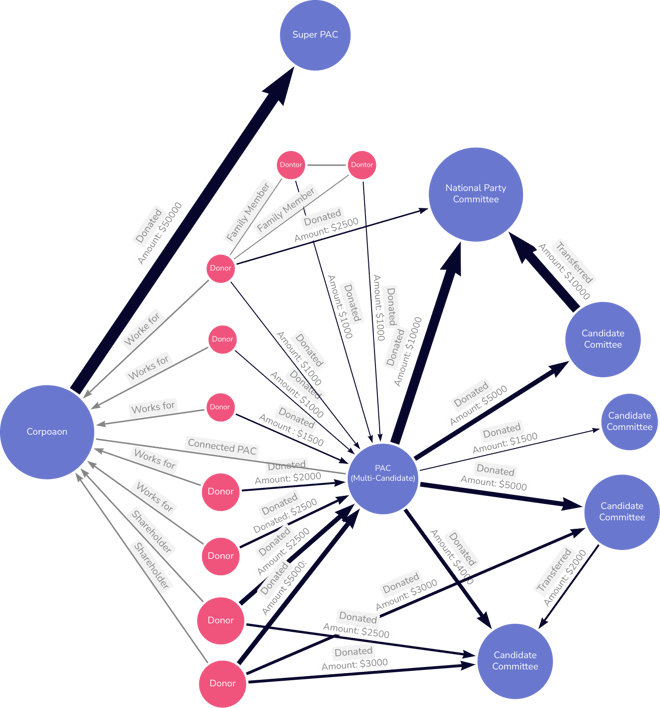- Strong Data UX helps your graph pilot succeed
- Focus on alleviating pain points for the business and the user
- Providing value to users is the key drive graph product adoption
Graph pilot projects show how graphs can answer complex business questions, but how do you turn a pilot into a product with buy-in from the business? While each project is different, there are some key strategies that will help a pilot project succeed and set it up for funding development into a production product that users love.

Lessons Learned: Achieving Graph Pilot Project Success
-
- Solve a Specific Problem: Conduct a Design Thinking Workshop to narrow the highest priority and most feasible problems to solve for your pilot project. When conducting the Design Thinking Workshop, be sure to include a diverse array of people who represent various types of users. After the workshop, vet findings with actual users so that you know you are solving the right problem. Creating an amazing graph database solution that pulls data from disparate sources is a great achievement, BUT if it doesn’t help address a business challenge and create value for the business and the users, the project won’t get past the pilot stage.
- Get Buy-in: Leverage the workshop environment to give everyone a chance to speak and vote on what gets included in the pilot. Business value as well stakeholder buy-in are both important to the success of a pilot project. Workshops will help gain buy-in and surface the business pain points that will lead to value creation opportunities. It is critical here to understand how users think and behave today; just because something is a pain, doesn't mean people want to or are ready to change. Go deep on finding out just how important it is for a problem to be solved and why. This is a good time to document expected outcomes and how you'll measure and report on progress toward achieving those outcomes.
- Provide Business Value: We have come across a lot of pilot projects that have the buy-in of key executives and plenty of funding, but don’t provide any real business value. As the leader of the project, you need to drive the solution to create business value AND get buy-in from the business, workshops are great vehicles to achieve buy-in and understand business challenges.
- User-driven Use Cases: Invite users into your workshop discussions through survey results, customer feedback, or user interviews so they have a voice in defining a solution they need. From our experience, successful pilots solve use cases driven by the end user, not the data team. A lot of pilot projects fall into this trap, what sounds cool and interesting to the data team may not align with what the end user or the business finds valuable.
- Solve a Specific Problem: Conduct a Design Thinking Workshop to narrow the highest priority and most feasible problems to solve for your pilot project. When conducting the Design Thinking Workshop, be sure to include a diverse array of people who represent various types of users. After the workshop, vet findings with actual users so that you know you are solving the right problem. Creating an amazing graph database solution that pulls data from disparate sources is a great achievement, BUT if it doesn’t help address a business challenge and create value for the business and the users, the project won’t get past the pilot stage.
Pro-tip: Be careful of data team lead solutions.
Successful solutions focus on alleviating pain points of the users, consumers and business leaders, not interesting insights the data team can create.
-
- Personas and Journey Maps: Invest in user research of data pain points and document findings into personas (archetypes of users) and journey maps (a visual representation of a user’s data journey and pain points). Data personas and data journey maps are great ways to understand the pain points of the potential users of the solution and how the data will flow from the source system into the solution.
- Start with Small Effort and High Value: T-shirt size features as S, M, L effort for your pilot and identify low-hanging fruit by giving each feature a user value. Those with L user value and S effort are going to give you quick wins.
- Personas and Journey Maps: Invest in user research of data pain points and document findings into personas (archetypes of users) and journey maps (a visual representation of a user’s data journey and pain points). Data personas and data journey maps are great ways to understand the pain points of the potential users of the solution and how the data will flow from the source system into the solution.
-
- Ongoing User Communication: Plan for ongoing user dialog, show them your work, demo to them, let them test drive your pilot. Working with your end users is the best way to understand the business value you are proving out.
-
- Clearly Define and Measure Business Value: Identify SMART business and user KPIs up front and measure those KPIs at each phase gate. Business value should be the main decision factor during the project. When you come to crossroads in a pilot project, and you will, the voice of the user must be vocalized and aligned to the value of objectives.
-
- Pilot Roadshow: Get your sponsors together with your implementation experts and do a “road show” to socialize and excite others about the work you are doing. Graph pilot projects are a vehicle to educate the business stakeholders on the power of graph technology. Knowledge graphs and graph projects are great opportunities to educate the business stakeholders on the power of graphs to solve complex business problems.
Pro-tip: Do a roadshow.
The conversations you have with the business stakeholders will help you identify excellent challenges that your graph project could potentially solve. Try to integrate a business leader lead use case into your solution and demonstrate that use case in the roadshow.
-
- Speed and Cost: An easy way to get pilots going is to create a prototype and test it with users. Graph pilots are inexpensive and quick to implement, and using prototypes to kick them off is smart - use this to your advantage. Speed is the name of the game, create quick proof of concepts to demonstrate the value these projects can bring to the business. Business leaders love to see quick results that solve problems. Small wins will lead to more chances to solve larger challenges.
- Data Viz for the Win: Data visualizations are a fantastic conversation tool. Creating a clickable data visualization showing how people are connected is a better use of time than trying to get stakeholders bought into graph theory or understanding the benefits of graph database technology.
Pro-tip: Visuals need to be insightful.
Focus your visualizations on the value relationship insights can bring to the business. Real life examples are powerful examples.
-
- Use the Right Tech: Knowledge graphs and graph solutions are not a one size fits all solution. They work spectacularly well in some situations, but are ill-suited for others. Make sure you are not putting the technology first. Focus on the business value the solution provides and find use cases well suited for a graph solution, not the technology that will be providing it.
Bottom line...
Provide value to users to help drive graph product adoption.
Want to position your graph pilot for success?
Try our 8-Week Data Value Accelerator program. Our approach gives knowledge workers the information, data consumers governance, and business leaders the value they need. Talk to our Data Practice Lead to learn more.
- Use the Right Tech: Knowledge graphs and graph solutions are not a one size fits all solution. They work spectacularly well in some situations, but are ill-suited for others. Make sure you are not putting the technology first. Focus on the business value the solution provides and find use cases well suited for a graph solution, not the technology that will be providing it.
.jpg)



